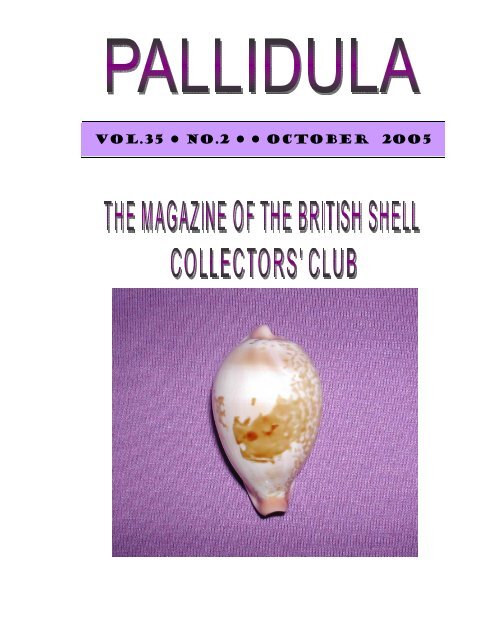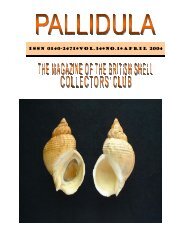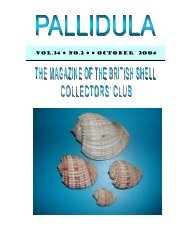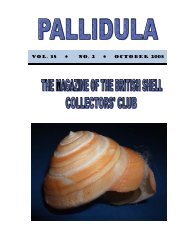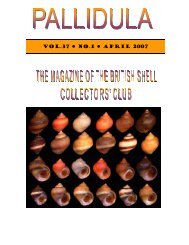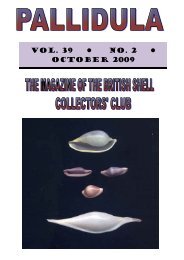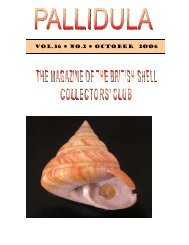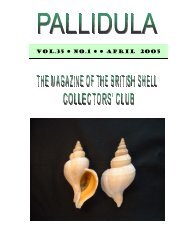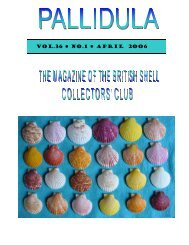VOL.35 NO.2 OCTOBER 2OO5 - British Shell Collectors' Club
VOL.35 NO.2 OCTOBER 2OO5 - British Shell Collectors' Club
VOL.35 NO.2 OCTOBER 2OO5 - British Shell Collectors' Club
You also want an ePaper? Increase the reach of your titles
YUMPU automatically turns print PDFs into web optimized ePapers that Google loves.
<strong>VOL.35</strong> <strong>NO.2</strong> <strong>OCTOBER</strong> <strong>2OO5</strong>
Page 2 PALLIDULA<br />
COVER PHOTOGRAPH<br />
Nesiocypraea hirasei (Roberts, 1913) – “The Rhino”<br />
I chose this particular specimen of Nesiocypraea hirasei as I thought it would make an interesting front cover<br />
picture. It does not require much in the way of imagination to work out the perfectly natural image of the head and<br />
neck of a rhinoceros on the dorsum of the shell.<br />
In the book “Cowries of the World” by C. M. Burgess, the author mentions on page 171 that he has a specimen of N.<br />
hirasei with an outline map of the USA, including Florida, the Texas bulge and the Great Lakes.<br />
Our cover specimen was obtained from a dealer in the Philippines, and was taken from tangle nets set at 120 meters<br />
off Mindanao, Balut Island, September, 2004.
PALLIDULA Page 3<br />
<strong>Shell</strong>s in Unusual Places<br />
This summer on a holiday I went on a tour of<br />
the Royal Yacht Britannia which is moored on<br />
the River Forth at Leith, nr. Edinburgh. It is a<br />
beautiful ship and still maintained in pristine<br />
condition and well worth a visit. In one of the<br />
alcoves in the State Dining Room hanging on<br />
the wall I photographed this splendid specimen<br />
of a Cassis madagascariensis which had been<br />
given to the queen on a visit to the West<br />
Indies. The small plaque says “Conch <strong>Shell</strong>,<br />
Caribbean 1966”.<br />
Daphne Howlett
Page 4 PALLIDULA<br />
THE BSCC TROPHIES<br />
by Tom Walker<br />
The <strong>Club</strong> awards several trophies at its annual <strong>Shell</strong> Shows, and usually the names of the winners are published in<br />
the next issue of Pallidula. However, no comprehensive list of winners seems to have been kept, and some years the<br />
names have been omitted from Pallidula. I thought it time that this was rectified, and the list below gives all the<br />
winners since each trophy was first awarded.<br />
Members may also like to know why we have these awards, and why they are so named. The newest cup – the John<br />
Fisher Trophy – is not included here, having been first awarded in 2004, won by Christopher Wilkins; full details<br />
about this cup were published in the October 2004 edition of Pallidula. Also not listed here is the new Scotia Shield<br />
which is to be awarded for the first time this year; for further details see page 6.<br />
The first <strong>Shell</strong> Show was held in May 1976, but competitive entries were not introduced until the following year. It<br />
seems that in the early years of the <strong>Club</strong> there was an additional award, the Du Pont Trophy, for the Outstanding<br />
Exhibit, but there is mention of only one winner; Ken Wye won it in 1977 for “Exhibit 38 in Class 10: Visual Beauty –<br />
Shape”.<br />
Conchologists of America Plaque<br />
The COA is the premier shell organisation in America, with well over 1000 members worldwide, the majority living in<br />
the US. The BSCC is a club member, and, to my knowledge, there are nine UK individual members.<br />
The COA strongly supports the educational and research aspects of conchology, and each year makes many grants<br />
to further this aim; in 2004 they awarded $14,583 to 11 workers, most of whom are students, but some professionals<br />
also receive grants.<br />
They are very active in supporting local shell clubs throughout the world, and show their support by donating a Plaque<br />
to member clubs for “a single scientific (vs. artistic) exhibit which best advances the interest in shells and shell<br />
collecting” (wording taken directly from their guidelines.) It may only be given to a first prize winner in any class, and<br />
cannot be awarded to a dealer unless the exhibit consists entirely of self-collected shells, nor to any professional<br />
malacologist.<br />
The BSCC is extremely grateful to the COA for donating this Plaque every year since 1979. To date it has been won<br />
by 16 different <strong>Club</strong> members, of whom six have won it more than once. The clear ‘winner’ is Stanley Francis who<br />
has received this award no fewer than five times.<br />
The Peter Oliver Cup<br />
Peter Oliver was born in 1918 and died in 1984, following which the BSCC Committee decided to award a Cup in his<br />
memory. His interest in shells began in 1960 when he was working as a public relations officer for the <strong>Shell</strong> Oil<br />
Company in Singapore and Malaya, being a founder member of the local malacological society. He returned to<br />
England in 1966.<br />
He accumulated an extensive collection of marine gastropods, concentrating mainly on Cypraeidae, Volutidae and<br />
Conidae. He was a Fellow of the Linnaean and Zoological Societies of London, and an active member of the<br />
Conchological Society. He joined the <strong>British</strong> <strong>Shell</strong> Collectors’ <strong>Club</strong> early in 1973, only a few months after it was<br />
formed, and was its second President, from 1977 to 1979.<br />
He was the author of The Hamlyn Guide to <strong>Shell</strong>s of the World; first published in 1975 it remained in print for many<br />
years and was translated into numerous different languages.<br />
The Peter Oliver Cup was first awarded in 1985 for “The Best Educational Exhibit” at the annual <strong>Shell</strong> Show and until<br />
2004 was the only award which has the winner’s name engraved on it. The Cup has been won by 13 different<br />
members, only two of whom have won it more than once; Kevin Brown is obviously our leading educationalist, having<br />
his name recorded six times on the Cup plinth.<br />
The Walter Karo Trophy<br />
Walter Karo was a very regular exhibitor at BSCC <strong>Shell</strong> Shows, and was noted for the outstanding quality of the shells<br />
he showed – always the best that was possible to obtain; I recall a stunning exhibit of Pleurotomariidae soon after I<br />
joined the <strong>Club</strong>. It is probable that his interest in shells was stimulated by his close business association with Mr<br />
Mayer, the founder of the Eaton’s Seashells shop.
PALLIDULA Page 5<br />
Following Walter’s death in 1990 his family offered his collection to the Natural History Museum in London, and this<br />
now forms the majority of the molluscan exhibition in the Museum – well worth a visit for those who haven’t seen it.<br />
In 1991 the <strong>Club</strong> Committee decided that “an award in memory of the late Walter Karo will be given for a specimen of<br />
outstanding beauty”; the plaque has a mounted Cymbiola aulica on it. Perhaps one attraction of this award is that it is<br />
not possible to plan an exhibit with this Trophy in mind – it really only depends on the opinion of the judges on the<br />
day. However, that does not make its winning any the less attractive, there having been 9 different winners over the<br />
14 years since this Trophy was first awarded.<br />
CONCHOLOGISTS OF AMERICA<br />
PLAQUE<br />
PETER OLIVER CUP WALTER KARO TROPHY<br />
1979 Peter Sheasby<br />
Spiral of Murex<br />
1980 Fed Pinn<br />
Gastropods of Pondicherry, South India<br />
1981 Geoff Cox<br />
Bivalves - Veneridae<br />
1982 Walter Karo<br />
Volutes<br />
1983 Alex Arthur<br />
Trochidae in the Mediterranean Sea<br />
1984 Jenny Hogenard<br />
<strong>Shell</strong>s from Obhor Creek, Jeddah, Saudi Arabia<br />
1985 John Llewellyn-Jones<br />
Kevin Brown<br />
Mother-of-pearl<br />
“Why is the shell that funny shape?”<br />
1986 Stanley Francis (joint)<br />
Colin Narbeth<br />
Chlamys opercularis<br />
Kevin Brown (joint)<br />
Penny plain two pence coloured<br />
Chinese money cowries<br />
1987 Tom Walker<br />
Kevin Brown<br />
Jamaican shells<br />
“An open or shut case”<br />
1988 Stanley Francis<br />
Koen Fraussen<br />
European Pectinidae<br />
Freshwater mussels<br />
1989 Alan Seccombe<br />
Geoff Cox<br />
Worldwide Cassidae<br />
<strong>British</strong> marine shells<br />
1990 Andy Wakefield<br />
Kevin Brown<br />
Worldwide Marginellidae<br />
“Teredo: the most expensive shell in<br />
the world”<br />
1991 Noel Gregory<br />
Kevin Brown<br />
Tom Pain<br />
Chicoreus<br />
“Gmelin 1791”<br />
Skirocus macrum (ammonite)<br />
1992 Stanley Francis<br />
Mike Dixon<br />
Geoff Cox<br />
Victims of the Florida Crab Traps<br />
Guide to Naticidae<br />
Harpa costata<br />
1993 Stanley Francis<br />
Kevin Brown<br />
Geoff Cox<br />
Mediterranean Muricidae<br />
Worldwide Neritidae<br />
Ericusa sowerbyi<br />
1994 Dick Plester<br />
Stanley Francis<br />
Geoff Cox<br />
Mitrinae<br />
The Mollusca – forerunners of our<br />
Modern Civilisation<br />
Buccinum undatum<br />
1995 Peter Sheasby<br />
Peter Sheasby<br />
Fred Pinn<br />
“Murex in the Pink – or is it in the Orange?” Molluscs and egg cases<br />
Chicoreus spectrum<br />
1996 Dick Plester<br />
Fred Pinn<br />
Geoff Cox<br />
Costellariidae<br />
The Sacred Chank of India<br />
Cassis tuberosa<br />
1997 Stanley Francis<br />
Kevin Brown<br />
Tom Walker<br />
Colourful <strong>British</strong> Marine <strong>Shell</strong>s<br />
Astrea heliotropum<br />
Cassis madagascariensis<br />
1998 Tom Walker<br />
Geoff Cox<br />
John Whicher<br />
<strong>Shell</strong>s Alive<br />
The Algorithmic Beauty of <strong>Shell</strong>s Vasum horridum<br />
1999 Kevin Brown<br />
Terry Wimbleton<br />
Dominic Rawlinson-Plant<br />
Millennium musing on Molluscs<br />
Helix aspersa<br />
Cypraea tessellata<br />
2000 Dick Plester<br />
Terry Wimbleton<br />
Dominic Rawlinson-Plant<br />
Genus Haliotis<br />
<strong>British</strong> marine molluscs<br />
Harpa goodwini<br />
2001 John Llewellyn-Jones<br />
Deborah Hicklin<br />
Selina Wilkins<br />
Mother of pearl buttons<br />
<strong>Shell</strong>s from Brittany<br />
Smaragdia viridis<br />
2002 Karen Hicklin<br />
Karen Hicklin<br />
Tom Walker<br />
Helcion pellucida<br />
Helcion pellucida<br />
Forcartia buehleri<br />
2003 Tom Walker<br />
Selina Wilkins<br />
Carl & Craig Ruscoe<br />
African shells with stamps<br />
Mya arenaria<br />
Aporrhais pesgallinae<br />
2004 Mike Dixon<br />
Sharon Crichton<br />
Mike Dixon<br />
Australian Top <strong>Shell</strong>s<br />
Studland Bay <strong>Shell</strong>s<br />
Clanculus undatus occidus
Page 6 PALLIDULA<br />
A Twelfth Century Cowry<br />
by Julian Joseph<br />
Introduction<br />
The base of a cowry shell was found in a 12 th – 14 th century archaeological site near Cambridge. There was<br />
also a fragment of cowry shell, and a piece of an oyster shell which it has not been possible to identify.<br />
The feature from which the shell came contained a partial human skeleton. The individual was estimated to be<br />
approximately 15 years old at time of death, but the sex of the remains could not be determined. Some of the<br />
bones were missing and were described as disarticulated when recovered, suggesting that this was a reburial.<br />
In addition to the shells, a spindle whorl, a pierced coin and a bead were found in the feature.<br />
The company responsible for investigating the site, Archaeological Solutions, asked the BSCC to find someone<br />
to write a report about the cowry fragment. The following is the result.<br />
A brief overview of the cowries<br />
The cowries are a group of approximately 230 living species of marine gastropod molluscs. They belong to the<br />
superfamily Cypraeacea, which includes 3 main families: Ovulidae (egg shells) Triviidae (includes the <strong>British</strong><br />
“cowries”) and Cypraeidae (the “true” cowries). The family has a worldwide distribution between the latitudes of<br />
approximately 40° north and 40° south. The majority of species inhabit warm, shallow water in the Pacific and<br />
Indian Oceans; there are a few species in the Caribbean Sea, and a number of species in the cooler waters of<br />
the Mediterranean, southern Africa and southern Australia.<br />
The shell<br />
The shell of a cowry is typically domed, with a flat base and almost bilaterally symmetrical. It is usually solid and<br />
glossy, and often very colourful. They range in size from approximately 10-150mm., depending on the species.<br />
The spire, usually prominent in gastropod shells, is small and completely, or almost completely hidden in adult<br />
specimens of most species. The aperture is reduced to a narrow slit, usually with teeth along both edges.<br />
Like all shells, that of a cowry is made of a combination of needle-like crystals of calcite and aragonite (both<br />
forms of calcium carbonate) and a fibrous protein component. In cowries, the crystals are arranged in layers,<br />
with crystals in different layers aligned in different directions, thus preventing fractures from spreading across<br />
the shell when it is stressed. The protein surrounds the crystals, giving extra strength. The outermost layer is<br />
usually highly polished.<br />
<strong>Shell</strong> terminology<br />
The following diagram shows the parts of a cowry shell as viewed from the base:
PALLIDULA Page 7<br />
Habitat and biology<br />
Most cowry species live in association with coral reefs in tropical and subtropical regions, in depths of less than<br />
25m. Some deeper or cooler water species live in association with sponges or among sea grass. Some species<br />
are herbivorous, feeding on seaweed; most, however, are predators, often feeding on sponges, or scavengers.<br />
Description of the specimen<br />
The specimen consists of the basal part of a cowry shell. It measures 72.8mm. in length, and 42.8mm. in width<br />
at its widest surviving part. The columellar side is somewhat flat.<br />
Basal view of the specimen Top view of the specimen<br />
Within the aperture, the fossula and columella are broken away, leaving a length of fossula about 5mm. wide<br />
and making the aperture appear wider than it should be. The white outer layer of the shell is present anteriorly,<br />
but lost on the posterior two thirds. 19 columellar teeth remain on the white area, the rest being broken away.<br />
There are 23 labial teeth. There appear to be traces of calcareous worm tubes over the teeth and in the spaces<br />
between them. This indicates that the shell must have been empty when it was collected. The top of the shell<br />
is broken off and missing. The broken edge is rough, so it is unlikely to have been cut off. It is more likely to<br />
have been found in this condition.<br />
Identification of the specimen<br />
Examination of the small fragment shows it is the lower edge of the<br />
fossula. It appears to have broken off recently, perhaps during<br />
excavation, as the break appears clean and new. It fits onto the<br />
corresponding broken edge of the fossula. The break is visible at the<br />
far left of the photograph (left).<br />
Identification was based mainly on the size of the specimen and the structure of the surviving teeth. The midcolumellar<br />
teeth are quite long, extending slightly over the base, and are plicate, i.e. they extend as long folds.<br />
This occurs in only one species of comparable size: Cypraea pantherina Solander, 1876. The general shape of<br />
the specimen is also consistent with this species.<br />
The surface is unusually flat for the species. This suggests that it could be the rarer northern subspecies<br />
rasnasraniensis Heiman, 2002, which has an almost flat base. However the shell does not seem sufficiently<br />
broad in comparison with its height. The ratio of width to length for rasnasraniensis is 0.61, and that for height<br />
to length is fairly constant at 0.52 1 . The ratio of width to length for the specimen in question is 0.588. However<br />
the widest part is missing, so this figure is slightly low. Width to length ratios for specimens of the nominate<br />
subspecies in my collection range from 0.57 to 0.596. That of the specimen in question is within the range for<br />
the nominate subspecies, but is slightly too narrow for the northern subspecies. Since the top part of the<br />
specimen in question is missing, the height to length ratio, which would give a more definitive indication of the<br />
subspecies, cannot be determined. Thus the subspecies cannot be determined with certainty.<br />
Approximate age at death<br />
The specimen seems to be an adult shell, in that all the surviving teeth appear to be fully developed. However<br />
the extremities appear to be slightly shorter than those of fully adult shells of the same species. This suggests it<br />
1 Heiman, 2002. Cowries of East Sinai, pages 43-4.
Page 8 PALLIDULA<br />
is a young adult, so it was probably approximately 7-12 months old 2 at the time of death. Size is not affected by<br />
age. When the animal reaches maturity, the outer lip of the shell turns in so that the aperture becomes a slit,<br />
and growth ceases except for a thickening of the shell, especially at the margins and extremities.<br />
Characteristics of the species<br />
The average length of an adult shell of Cyprarea pantherina is in the range 56-74mm. The shape is somewhat<br />
elongate-pyriform. The sides and base are white; the teeth are fine, the columellar teeth are plicate and extend<br />
over base. The upper surface is very variable in colour, from whitish to chestnut red, with numerous blackish<br />
brown spots, with a pattern similar to that of the well known “tiger cowry”, Cypraea tigris Linnaeus, 1758.<br />
Cypraea pantherina is closely related to C. tigris, which is heavier and less elongate, with fewer, coarser teeth<br />
and marbled sides in mature specimens. C. tigris is distributed throughout the Indian and Pacific oceans, but<br />
does not overlap with C. pantherina.<br />
Variations in Cypraea pantherina, upper row: dorsal view, lower row: basal view. All specimens are in the<br />
collection of the author.<br />
Cypraea pantherina, dark<br />
red, rostrate form, Jeddah,<br />
Red Sea.<br />
68.4 x 38.7 mm.<br />
Cypraea pantherina,<br />
Dahlak Is, Red Sea.<br />
59.1 x 35.0 mm.<br />
2 Dr. Felix Lorenz, personal communication.<br />
Cypraea pantherina,<br />
Elat, Northern Red Sea.<br />
67.3 x 39.6 mm.<br />
Cypraea pantherina,<br />
pale specimen, no locality<br />
data.<br />
64.1 x 38.0 mm.
PALLIDULA Page 9<br />
Cypraea tigris, Sabah, East<br />
Malaysia. 85 x 59.3mm.<br />
Left: dorsal view, right: basal<br />
view.<br />
Specimen in the collection of the<br />
author.<br />
Habitat, distribution and biology<br />
Cypraea pantherina is endemic to the Red Sea and the Gulf of Aden. It has been found near Massawa in 3m.<br />
or more of clear water in areas of abundant coral. It is usually found under slabs or in crevices on hard coral<br />
reefs, in 0.1-1.5m. of water. It is mainly active at night, but also moves about during the day. C. pantherina<br />
rasnasraniensis Heiman, 2002, the northern subspecies, is restricted to the east coast of the Sinai peninsula<br />
and the extreme northern part of the Red Sea.<br />
Little seems to be known about the biology of Cypraea pantherina. Specimens in captivity have been observed<br />
to feed on bivalve molluscs. They may also feed on dead organic matter.<br />
Uses of cowries<br />
Cowries have been put to many uses in various parts of the world at different times. The most common of these<br />
are as money and as charms.<br />
Money<br />
Small species, mostly Erosaria moneta (Linnaeus, 1758) and E. annulus (Linnaeus, 1758), served as currency<br />
in ancient China (during the Shang (1600 – 1100 BC) and Zhou (1100 – 221 BC) Dynasties). More recently,<br />
they were used as money in India and in parts of Africa. They are said to have been used in some remote parts<br />
of Africa as late as the 20 th century.<br />
Charms<br />
In many cultures around the world cowries were believed to confer fertility, protection against evil spirits and<br />
good luck in general. Pliny said cowries were consecrated to Venus, and specimens have been found in<br />
Pompeii. Cowries were carried when hunting, and were attached to fishing nets to act not only as weights but<br />
also to bring good luck for fishing.<br />
Other uses<br />
Large cowry species such as Cypraea tigris Linnaeus, 1758 have in the past been eaten in a number of islands<br />
in the Indian and Pacific oceans, for example Hawaii (boiled) and the Philippines (dried then fried). The large<br />
and attractive “Golden cowry” Lyncina aurantium (Gmelin, 1791) was used as a badge of rank by chiefs in Fiji.<br />
In ancient Athens, cowries were used as ballot balls for voting. In Italy they were used for burnishing paper.<br />
Cowries are said to have been carried far and wide by Gipsies. They were shipped to Europe in large quantities<br />
in the 19 th century.<br />
Occurrence of cowries in European graves<br />
Cowries have been found in early graves in England, France and Germany with other personal objects buried<br />
with women, some pierced for suspension as pendants, some resting on the skeleton in pairs, suggesting<br />
attachment to garments. Several have been found in Saxon women’s graves in Kent and Somerset. In one of<br />
these, in Somerset, possibly 7 th century, a C. pantherina, pierced at one end, was found with a piece of chalk<br />
cut into the shape of a heart, a large boar tusk, a thick iron pin 2.5” long, a flint scraper and a Roman coin
Page 10 PALLIDULA<br />
beside the skeletons of a woman and a 7 month old child. Cowries were believed to ensure life and<br />
resurrection 3 .<br />
Dr. Felix Lorenz (personal communication) said C. pantherina was also found in 5 th century Merowingan graves<br />
in Southern Germany. Only wealthy women had them in their graves. He was of the opinion that they came<br />
from the Yemen area.<br />
Conclusion<br />
The base of a cowry shell found in a 12 th -14 th grave near Cambridge appears to be from a shell of Cypraea<br />
pantherina. Specimens of the same species have been found in other early English and European graves. It<br />
was probably intended as a charm rather than as an ornament. Its presence suggests that the human skeleton<br />
with which it was found was probably that of a woman.<br />
Aperture<br />
The opening of a shell.<br />
Glossary<br />
Columella The central axis of a coiled shell, formed by the inner wall of the whorls and<br />
often forming a thickened inner lip.<br />
Columellar teeth Teeth along the columellar (inner) lip.<br />
Fossula A spoon-shaped depression at the anterior end of the columellar lip of a cowry<br />
shell.<br />
Gastropod A mollusc with a single shell. The shell is usually coiled (spiral).<br />
Labial teeth Teeth along the outer lip.<br />
Nominate<br />
subspecies<br />
The subspecies that represents the species as originally named, e.g. Cypraea<br />
pantherina pantherina.<br />
Pyriform Pear-shaped.<br />
Rostrate With produced, beak-line extremities.<br />
Spire The coils of a gastropod shell. In cowries, this is very small and often not<br />
visible.<br />
Subspecies A population of individuals differing significantly from other populations of the<br />
same species.<br />
Teeth Ridges that run along both edges of the aperture of a cowry shell.<br />
References<br />
Allan, J. 1956. Cowry <strong>Shell</strong>s of World Seas (Georgian House, Melbourne)<br />
Burgess, C. M. 1985. Cowries of the World (A. S. Barnes & Co., New York)<br />
Heiman, E. L. 2002. Cowries of East Sinai (Keterpress Enterprises, Jerusalem)<br />
Lorenz, F., 2002. New Worldwide Cowries (Conchbooks, Hackenheim, Germany)<br />
Lorenz, F. and Hubert, A. 2 nd ed., 2000. A Guide to Worldwide Cowries (Conchbooks, Hackenheim, Germany)<br />
Naerbeth, C. November, 2004. The Cowry <strong>Shell</strong> as Money, in Mollusc World Issue 6 (Conchological Society of<br />
Great Britain and Ireland)<br />
Taylor, J. and Walls, J. G. 1975. Cowries (T. F. H. Publications, New Jersey)<br />
Acknowledgements<br />
Thanks are due to John Batt for assistance with identification and with the determination of the degree of<br />
maturity of the shell, and for reviewing the final draft. I would also like to express my gratitude to Dr. Felix<br />
Lorenz for information on the longevity of C. pantherina and on its occurrence in early German graves, and to<br />
Archaeological Solutions for permission to reproduce this article in Pallidula.<br />
3 Allan, J. 1956. Cowry <strong>Shell</strong>s of World Seas, page 6.
PALLIDULA Page 11<br />
SHELLING ON SHELL ISLAND, WALES – APRIL 2005<br />
by David Hutchinson<br />
For anyone with an interest in marine shells of the UK, <strong>Shell</strong><br />
Island is a place to visit. It is situated near Harlech on the<br />
A496 Barmouth to Harlech Road, then follow the signs at<br />
Llanbedr for <strong>Shell</strong> Island.<br />
Being an island one must check the local tides as <strong>Shell</strong> Island<br />
is connected to the mainland by a causeway which is flooded<br />
every day at high tide. One can usually drive onto the island<br />
around lunchtime, but times vary with the time of year, and<br />
leave early evening before the road becomes flooded again.<br />
There is a charge to enter <strong>Shell</strong> Island of around five pounds<br />
per car but this is very cheap for the wide variety of shells one<br />
can collect.<br />
With a listed total of around 200 species one cannot fail to find<br />
interesting shells for ones collection. I have concentrated on<br />
the main beach which is opposite the main entrance. Thousands of common shells litter the beach<br />
and my best results were to find a large pile of these shells and brush them away until you reach the<br />
sandy beach, then look in the sand and you may find the three spot cowry Trivia monacha, never in<br />
large amounts but quite common, all are in perfect gem condition. In the same sand one can find<br />
Dentalium vulgare, the tusk shell, again in good condition.<br />
Further along the beach I found Acteon tornatilis,<br />
hard to find in good condition and not common,<br />
always in grit at the top of the beach. Gari fervensis<br />
was common on the central beach (shown on the left)<br />
on the surface but very dirty and rarely complete but<br />
with a lovely pink colour. Donax vittatus is a very<br />
common shell all along the central beach with some<br />
lovely colour forms including deep yellow, many<br />
shells being complete. The large shell Dosinia<br />
exoleta can be picked up easily often in perfect<br />
condition; this is one of my favourite shells. Ensis<br />
siliqua is scattered all over the beach, in very good condition with nice purple bands. A number of<br />
Cardium species litter the beach never complete and none worth collecting. Cardium echinatum was<br />
seen only in single valves and I never found one complete specimen; the same applies to Cardium<br />
edule. My next find was Lutraria lutraria, a very large<br />
shell resting on the sand. In a rock pool (shown on the<br />
right) I found a very large Natica catena. These were<br />
much smaller on the main beach and rather worn but<br />
very common.<br />
After searching all day I found only three specimens of<br />
Aporrhais pes-pelecani, one in gem condition. <strong>Shell</strong><br />
Island is also the home of the common Tellina fabula in<br />
a lovely red shade. Another interesting find on the<br />
main beach was Turritella communis, two large shells<br />
together buried in sand. Clathrus clathrus also occurs
Page 12 PALLIDULA<br />
on the main beach in large numbers but is hard to find in good condition. All in all I collected 34<br />
species on the central beach.<br />
After a break for tea I spent the rest of the day searching the rock pools and the large rocks near the<br />
sea. In the pools I found many Nucella lapillus, some very large, along with a number of nice micro<br />
shells (none of which I can identify, help required), one with black vertical lines and very pretty; also in<br />
the pools were Trivia monacha again in large numbers. My next find were some large Littorina<br />
littorea, these shells are always small where they are collected in large numbers for food. On the<br />
large rocks were some lovely forms of Littorina saxatilis, many with bands and some nice orange<br />
forms. Also on the rocks were many forms of Littorina littoralis including orange and green with<br />
banded forms being less common. Monodonta lineata were in hundreds on the rocks, all large and in<br />
good condition.<br />
Having spent two days on <strong>Shell</strong> Island it was time for me to return home with many shells for my<br />
collection.<br />
Useful contacts are:- <strong>Shell</strong> island information centre – tel. 01341-241453 or www.shellisland.co.uk.<br />
Tide charts are available at Barmouth Angling Shop or ask at <strong>Shell</strong> Island main entrance for latest<br />
leaving times in the evening. Opening times are March 1st until November 30 th . One can camp on<br />
the island and food is available in the island shop and café. Best collecting times are March and April,<br />
avoid summer months, then again in October and November.<br />
Many thanks to Carl Ruscoe for help with collecting sites on the island. The main beach is very rocky<br />
at the sea edge and good strong waterproof shoes are required to explore the rock pools and a hat to<br />
avoid sunburn. With Harlech Castle in the distance and views of Lleyn Penninsular, <strong>Shell</strong> Island is a<br />
wonderful place to visit either camping or staying at Barmouth just ten minutes away.<br />
Below is a photograph of some of the specimens collected on <strong>Shell</strong> Island.<br />
1. Natica catena (da Costa, 1778)<br />
2. Gari fervensis (Gmelin, 1791)<br />
3. Aporrhaispes-pelecani (L., 1758)<br />
4. Chlamys opercularis (L, 1758)<br />
5. Turritella communis Risso,1826<br />
6. Trivia monacha (da Costa,1778)<br />
7. Clathrus clathrus (L., 1758)<br />
8. Donax vittatus (da Costa, 1778)<br />
9. Cardium echinatum (L., 1758)<br />
10. Dosinia exoleta (L., 1758)<br />
11. Tellina fabula - red Gmelin, 1791<br />
12. Acteon tornatilis (L., 1758)
PALLIDULA Page 13<br />
A NEW CONUS SPECIES FROM THE PHILIPPINES<br />
by Mike Filmer<br />
Late last year fellow member Alistair Moncur showed me five specimens of a large cone shell, which he had<br />
acquired from local Filipino collectors. My first impression was that these specimens were an unusual form of<br />
the very common Conus litteratus. I then spent some time studying them and came to the conclusion that they<br />
most likely represented a new species. I prepared a paper naming this new species after Alistair as Conus<br />
moncuri. The paper was published in the magazine "Of Sea and Shore" Volume 27, No. 1 in May 2005.<br />
In addition to the magazine the full description can also be found on the Of Sea and Shore website<br />
www.ofseaandshore.com and on Alistair Moncur's website www.aulica.com<br />
I hesitated for some time to describe a new cone of this size, so similar to C. litteratus and from the well shelled<br />
Philippine Islands. Also I would have preferred to have more detail about the range and habitat of this shell.<br />
However I found what I considered enough differences to justify naming a new species. No doubt some will not<br />
accept this new species status but others will and time will tell who is right. Since publication Alistair has<br />
obtained two more specimens from the Sulu Sea and Bohol. A very good friend of mine Jon Singleton of<br />
Western Australia discovered that he had a very nice specimen, which he obtained from a collection of shells<br />
from Papua New Guinea. At the recent Conchologists of America Show Victor Dan had, on display, a specimen<br />
also from the Philippines.<br />
It is most likely that other collections contain specimens and I suggest you take another look at your C. litteratus<br />
to see if you also have this species hidden among your litteratus.<br />
Conus moncuri – Holotype Conus moncuri – Paratype 1<br />
size: 98.5 x 54 mm. size 181 x 92 mm.<br />
Conus moncuri – Paratype 3 Conus moncuri – Paratype 5<br />
size: 145 x 75 mm. size: 110 x 59 mm.
Page 14 PALLIDULA<br />
<strong>Shell</strong> <strong>Club</strong> Members’ Get Together In The Summer<br />
This year there have again been two successful extra events for <strong>Club</strong> Members. On the weekend of<br />
25 th /26 th June over 40 members made their way to Rockland St Mary in Norfolk at the invitation of<br />
Daphne and Derek Howlett. Here they were able to talk shells, exchange shells, buy shells, sell<br />
shells etc, as well as admire the extensive Howlett collection. Their wide open garden is ideal for the<br />
marquee to house the “dealer” element of the members and their shells, whilst nearer the bungalow<br />
we could just sit in the sun, talk, and enjoy each other’s company.<br />
The highlight this year was a superb<br />
barbecue, the centre-piece being a<br />
delicious lamb which had been<br />
expertly spit-roasted over 6½ hours by<br />
our <strong>Club</strong> Secretary / Chef, Tom<br />
Walker.<br />
Many members travelled here for the<br />
day from Essex to Birmingham, whilst<br />
those who come from further afield<br />
have now made a habit of staying in<br />
local bed and breakfast<br />
accommodation to make the most of<br />
the weekend. It is also a good<br />
opportunity for new members to meet<br />
with the old hands and we were<br />
pleased to welcome Debra and<br />
Russell Walker, and Sally, Matt, Laura<br />
and Sam Ashdown all of whom are our newest members.<br />
On the 6 th August John and Goga Batt were once again the hosts at their home in Yateley,<br />
Hampshire. Twenty-seven members came to enjoy a “surfeit of shells”, plus the chance to see John’s<br />
great collection of the world’s cowries.<br />
Both Alistair Moncur and Mike Filmer were present and had bought along the Holotype and<br />
Paratype’s of the new Conus moncuri to show and discuss with fellow members.<br />
With good company and good<br />
food a super day was had by all.<br />
Funny how “shellers” all enjoy<br />
their food!<br />
These get-togethers give all of<br />
us the time to get to know one<br />
another, our families and our<br />
individual interests.<br />
Unfortunately there is never time<br />
to indulge in this at the <strong>Shell</strong><br />
Shows in April and October. If<br />
you’ve never been to one of<br />
these events, why not put the<br />
dates for 2006 into your diary,<br />
and come and enjoy a different<br />
aspect of the <strong>Club</strong>.
PALLIDULA Page 15<br />
Spurn Head<br />
by David Hutchinson<br />
Spurn Head is located at the mouth of the Humber estuary near Hull. Being a well known nature<br />
reserve it is popular with birdwatchers and walkers. Spurn Head is a long narrow strip of sand with a<br />
road running down the centre taking you to the lighthouse at the top of the point, where there is a<br />
large beach and some very large sand dunes. For the shell collector there are both land snails and<br />
marine shells which both occur on the main estuary beach. Strong cross winds blow the land snails<br />
off the dunes and leave them on the beach with the<br />
marine shells which I find quite unusual. The main<br />
feature on the estuary beach is large amounts of sea coal<br />
which the locals used to collect for use on their fires<br />
when coal was expensive and in short supply after the<br />
Second World War.<br />
Starting with the land snails, Cernuella virgata is a<br />
common shell on the beach, and both mature and<br />
juvenile specimens occur together making identification<br />
quite difficult. The next land snail to be found in large<br />
numbers was the very common Helix aspersa but in a<br />
very pretty white banded form. This common garden species is more often brown and quite drab but<br />
the shells at Spurn Head are very attractive with thick white bands over a brown background. My next<br />
find were some really nice Cepaea nemoralis; again I had problems with identification of a number of<br />
brown unbanded shells which were just extremes of a normally banded species. I also found some<br />
lovely yellow unbanded shells which were again the same species.<br />
The typical Cepaea nemoralis occurred in a range of pretty forms including pink with brown stripes. A<br />
local species of fly uses the dead snail shells in which they lay their eggs, I discovered this some time<br />
of putting the shells into sealed bags when a number of flies had emerged and were trapped in the<br />
bag. I find it very unusual that a fly should use dead snail shells in such a way. I suppose that there<br />
must have been some of the dead mollusc left in the shell and this was sufficient for the maggots to<br />
live on.<br />
My last snail find was the freshwater snail, Anisus vortex. This was again found on the beach in a<br />
rock pool, a strange place to find a freshwater species. I am sure that many more species occur on<br />
the dunes, but with limited time I spent most of the day on the estuary beach looking for marine shells.<br />
All of my collecting was restricted to the first two hundred yards of the estuary beach; parking my car<br />
just after the entrance it is very easy to walk onto the beach. Further down, the dunes become very<br />
high and one must drive down to the very end, park and walk back along the beach.<br />
My first find in a rock pool was hundreds of large Hydrobia ulvae; for a common micro these shells<br />
were true giants. Because there are very few rocks on the beach the shells found washed up by the<br />
tide are in very good condition.<br />
Cerastoderma edule littered the beach in their hundreds all in perfect pairs. I find this species difficult<br />
to collect in good condition so I gathered some really nice specimens for my collection. The next<br />
species found were Nucella lapillus and Macoma balthica which covered the beach in a whole range<br />
of colour forms including pink, white and yellow. Some really interesting shell finds were some<br />
unusual Littorina littorea, having a thick white band at the base of the shell. I also found many<br />
juveniles of Littorina saxatilis which looked just like micro shell species.<br />
At this point I decided to look in the grit on the beach which was mixed with fine coal grains. With<br />
sieve in hand and plastic bags at the ready I found the two common estuary species, Abra abra and<br />
Abra tenuis in large numbers. These are both pretty white shells that can be collected in most<br />
estuaries. My next find was the very delicate Retusa obtusa. This is a very small micro living in
Page 16 PALLIDULA<br />
estuaries, not rare but a nice find. The grit was full of Hydrobia ulvae in a range of sizes along with<br />
tiny juvenile specimens of Cerastoderma edule; these are really cute.<br />
With rain starting to come down I walked back to the car having enjoyed a nice day collecting some<br />
lovely shells for my collection. I am sure there are many more snail and marine species for me to<br />
collect at Spurn Head and I hope to return in the near future. Being a nature reserve, however, only<br />
dead shells should be collected.<br />
Spurn Head Point, low tide – Boats going into Hull<br />
Being an estuary one can only expect to<br />
collect species that live in the estuary, but all<br />
of the shells are in such good condition due<br />
to the lack of rocks that it is well worth a<br />
visit.<br />
I must thank Carl Ruscoe and Derek Howlett<br />
for all their help with identification of shells<br />
and hope other collectors will enjoy a day<br />
collecting at Spurn Head.


